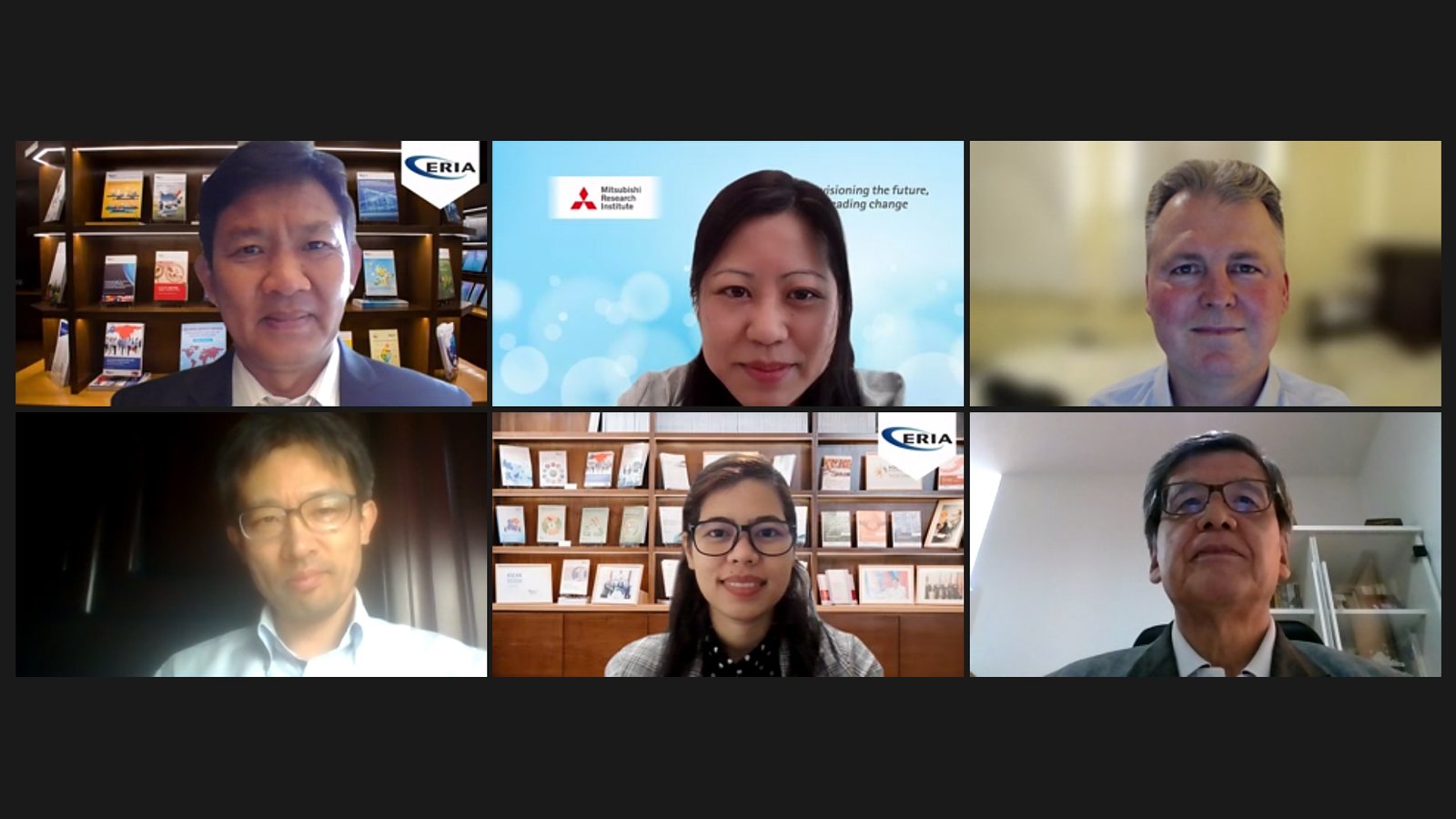CCUS Technical Workshop: Day 1-Technical Aspect of Carbon Capture Technology
Virtual Conference, 5 October 2021: The Carbon, Capture, Utilisation and Storage (CCUS) Technical Workshop is organised by the Economic Research Institute for ASEAN and East Asia (ERIA) and the Asia CCUS Network (ACN) to bridge the knowledge gap of CCUS technology and development. The Network strives to contribute to the decarbonisation of emissions in Asia through research, training, and knowledge sharing on CCUS technologies. The event is part of a workshop series that fall under the ACN’s capacity building training pillar, encompassing one of three core missions.
Opening Remarks and Introductory Remarks
Dr Han Phoumin, Senior Energy Economist of ERIA offered his Opening Remarks during the first day which covered the topic of ‘Technical Aspect of Carbon Capture Technology.’ He emphasised the importance of CCUS technology in Asia’s clean energy transition, adding that ‘it is the only technology that contributes both to reducing emissions in the highly energy-intensive sectors and to remove carbon dioxide (CO2) to balance emissions that cannot be avoided.’ To ensure its feasibility, it will be crucial for East and Southeast Asia to secure the investment, establish the right policies, and approve the necessary aid to develop then deploy this carbon-free innovation. Dr Phoumin explained that the experts must understand the technical aspects of CCUS thus the workshop aimed to enhance the understanding of this technology.
Mrs Kikuko Shinchi, Senior Researcher of MRI provided her remarks on the ‘Introduction to Capacity Building and Overview of CCUS Business Development in Asia’ where she stressed Asia’s CO2 capture initiatives must be considerably developed to meet Paris Agreement goals. Sharing estimates from the International Energy Agency (IEA), Mrs Shinchi explained that a ‘Sustainable Development Scenario’ aligned with the Paris Agreement will require CO2 capture in Southeast Asia to reach 35 megatonnes by 2030 and 200 megatonnes by 2050 thus action is urgently required.
Southeast Asia’s energy demand growth between 2015 – 2019 ranks second only after China and is projected to continuously increase. Considering that this growth has been and will continue to be driven predominantly by fossil fuels, ASEAN Member-States must address emissions fossil fuel consumption and supply. These expected trajectories are evidence as to why CCUS is especially important for ASEAN as it seeks to balance growth and carbon reduction measures. While there are various CCUS technologies available globally, each is at varying degrees of maturity.
Mrs Shinchi shared three solutions proposed by the IEA, the first being to CCS-retrofit fossil fuel power plants to provide flexibility to incorporate renewable energy (RE) in the energy grid as well as to allow co-firing with biomass, ammonia, or hydrogen. The second solution is to apply Carbon, Capture and Storage (CCS) to heavy industries such as cement, steel, and chemicals. The third solution highlight AMS’ crucial position in the natural gas supply chain thus capturing CO2 from gas reservoirs or turbines will be a key activity to undertake. Although the required investment of CCUS is considerably large, Mrs Shinchi asserted that the costs are lower than other options like hydrogen.
Presentations
The First CCUS Technical Workshop brought together leading technical experts across East and Southeast Asia to share their findings and research on CCUS and carbon-neutral innovation. With the world racing towards net-zero emissions by mid-century, it has become imperative for ASEAN to tackle the issue of CO2 reduction without jeopardising regional growth and prosperity. The technical knowledge from the event’s speakers serves to narrow the knowledge gap in high-tech innovations as well as to showcase the immense potential available in the carbon neutrality pathway.
Overview of Carbon Capture Technologies
Dr David Kearns, Principal Consultant-CCS technology, GCCSI provided his take on the advantages and disadvantages of carbon capture tech on the first day of the event. Dr Kearns stated methods such as DAC is important as it is an opportunity to achieve ‘negative emissions’ given that CO2 will remain even after the world pushes for deep decarbonisation. Dr Kearns covered three types of CO2 capture technologies: Absorption, Adsorption, and Membranes. Absorption uses a solvent that absorbs carbon dioxide from a gas into a liquid in which there are types of solvents available for use: Chemical and Physical.
Chemical solvents can absorb CO2 and react it into other species within the solvent itself hence there is the significant capacity to keep taking on carbon. Physical solvents absorb carbon and require higher operating pressure to squeeze the CO2 into the solvent compared to its chemical counterpart. Solvent types that have been used in this form of technology include potassium carbonate, liquid glycols, and amines such as Piperazine though more advanced and robust types of solvents are being explored. Dr Kearns explained that the equipment needed for absorption-based CO2 capture is quite large as it must deal with substantial volumes of gas hence must be taken into consideration in the construction of this technology. On the other advantages of this tech, Dr Kearns explained that ‘there are lots of configurations that involve different types of heat integration arrangements, multiple columns, and different types of packing.’
Adsorption is a solids-based approach to carbon capture which uses a solid material to capture CO2 from gas and adds it onto that solid. There are two approaches to adsorption: Temperature swing adsorption or pressure swing adsorption. The temperature swing method uses heat to drive the CO2 back off to the solid into the gas phase whereas the pressure swing method uses cycling between a high and low pressure to adsorb or de-adsorb CO2; both concepts are similar. The third form of carbon capture is a membrane-based technology that has a similar process to that of reverse-osmosis desalination of seawater. Dr Kearns stated that membranes are quite sensitive to moisture and will require a high level of pressure as compression is the main driver for membrane-based capture. The suitability of each type of technology varies where solvent-based processes are more suitable for locations where heat is abundant bearing in mind the large size of absorption plants. Adsorption plants are ideal if the location has an abundance of low-cost RE, and membrane-based plants are a more compact option than the other types.
Overall, CCS projects globally have grown at an average of 30% year-on-year growth since 2017 and especially in 2021. There are Carbon, Capture and Storage (CCS) projects underway in a wide range of sectors encompassing cement, iron and steel, power generation, waste to energy, chemicals, fertilisers, ethanol production, and DAC. Moving forward, Dr Kearns stressed the importance of achieving economies of scale to push prices and energy costs down, expand technological selection, and minimise the full-chain CCS costs on transportation and quality of storage resources.
Questions and Answers (QnA)
If DAC prevails around the world, could it break the CO2 balance in the atmosphere?
We have already upset the balance of CO2 by putting excessive amounts of it in the atmosphere which was not there 200 years ago thus technologies like DAC are helping us to restore the balance. It is important to note that having CO2 in the atmosphere to a certain is needed, but ultimately DAC is to restore the CO2 balance.
What types of technological innovations are needed to lower the cost of DAC?
Economies of scale are extremely important to bringing capital costs down as is access to cheap energy resources like renewable electricity. There will likely be tech improvements in the coming years, but it is too early days to make predictions on which approach is most successful in the DAC approach.
What can you tell us about aqueous ammonia for CO2 Capture technology?
I do not hear a lot of them about yet, but I have heard developments are on the way. It is a variation of the absorption technology, and their proponents believe that they have an advantage for certain applications. It’s important to remember that there is not going to be one technology that rules them all. I think we are going to see particular niches that are going to be dominated by particular technologies, and also the applications where all these techs are deployed in one form or another. It is a diverse industry with a diverse range of applications, and we’re going to need all these techs to deal with them.
What can you tell us about cryogenic carbon capture?
This method involves chilling the flue gas down directly, and while it has been available for a long time, it has proven not to be as cost-effective as some of the alternatives thus it is tended to get stuck at the research stage and struggle to break out of that. This is not to say that it could not change in the future. If you can carefully integrate the cryogenic operation with an air separation unit in a pre-combustion type scenario, you may be able to make it more cost-effective, but the progress on the commercial scale has been very limited.
How does GCCI view EOR in the context of CCUS?
Historically, EOR was one of the main drivers of developing carbon capture processes as it provided an economic incentive, but this was before any real focus on greenhouse gas emissions. The research suggests there is a net positive climate impact by putting CO2 into an oil field where the CO2 tends to stay there. Having said that, EOR is only going to go so far and for the levels of abatement that we require to go to net zero, we are going to need vast quantities of dedicated geological storage such as saline aquifers or depleted oil and gas fields.

